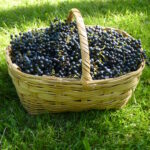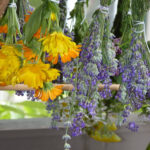I’m going to be doing a series of posts on wild foods, especially those that I’ve been gathering for a long time. Why wild foods? Wild foods are just that–they grow without cultivation, are delicious, and allow you to experience different kinds of flavors. When gathering wild foods, you want to make sure you are gathering in a sustainable way (in other words, don’t over-harvest and make sure you have permission–of all kinds–to harvest). My good friend Mark put together this awesome guide on ethical foraging–please read it before harvesting any wild foods!
The first wild food I’ll be discussing is: RAMPS!

What: Ramps are a plant native to North America (specifically, the eastern seaboard and Midwest regions). They taste like a cross between garlic and onion, and as the season goes on, Ramps take on stronger and stronger flavor. Ramps have a single bulb (which smells of onion/garlic and is quite unmistakable), two broad green leaves coming up from the bulb (the greens are also edible). Later in the season, the ramps will turn yellow and eventually produce a seed head (which produces black seeds and looks a lot like a chive head). Apparently, they have become commercially available in recent years, which I guess is a testament to their awesome flavor.
Where: Ramps can be found in wet forest areas. They especially like to grow in valleys where spring rains cause small springs to pop up–this is where I always find them. Look also along riverbeds and on the edge of marshes. They are a full shade, deep forest plant.

When: Ramps come into season usually in late April or early May. Depending on the warmth of the soil, they might come in a bit early (as was the case last year) or a bit later (as was the case this year–they were at their peak in the 2nd week of May this year) depending on spring weather.
What to harvest: The entire plant can be harvested anytime before it goes to seed. Once the plant is in seed (known as “bolting”) the energy of the plant shifts from the leaves and bulb to the seed production, so the flavor suffers.

How to Preserve: I’ve only attempted one preservation method, which is drying ramps in a dehydrator. They dry very quickly (4 or so hours) and break up into neat little rings. I highly suspect that they would store decently well in a root cellar. I’m also told they freeze well!

How to Eat: You can use the green leaves in any way you would a green onion. You can use the bulb like an onion or garlic. The photo below shows a wonderful fried rice dish that we made from wild woodland nettles (post on that soon), ramps, rice, and egg. It was divine!




I’ve never found them wild in Michigan. We do have slender wild chives here that are quite lemony. Usually where the mayapples or wild ginseng is growing.
We have successfully transplanted ramps to our yard, so that we don’t have to travel to a foraging site. We put them on similar terrain, at the foot of a slope with some shade. They struggle in dry springs, but even so they have spread so that we now have a good supply. My husband makes a fabulous “forager’s quiche” with them–ramps, fiddlehead ferns, and black morels.
That’s what I’m doing too, since we don’t have that many in Michigan. (The photos and harvesting took place at my parent’s house in PA when I was there recently!)
There are more ramps in Michigan than people! Where do you live?
South-east Michigan. I suspect there are a lot further north. I’ve heard of swaths of them growing near Traverse City :).
Thanks for the comment, Holly!
So glad I found your blog! I am interested in foraging wild foods too! Do ramps look a bit like scallions? I remember finding what I thought were wild onions as a child. I am traveling via semi-trailer and exploring wild foods in peripheral fields, woods etc. It is slow going but I also am reflecting on wild plants and wild flowers I remember when growing up….researching them for edibility and going from there! I look forward to more of your great posts!
They do look a bit like scallions, but are smaller than most varieties. They are really quite unmistakable–they have a cross of a scent between garlic and onions. There are other, taller, thinner looking wild onions that I’ve seen growing in the same region, but these don’t grow in the damp, dark, areas like ramps do. They look a bit more like chives.
That is helpful! Thankyou so much! I will look for ramps in the damper areas… thankyou so much for your reply! I look forward to more of your posts!